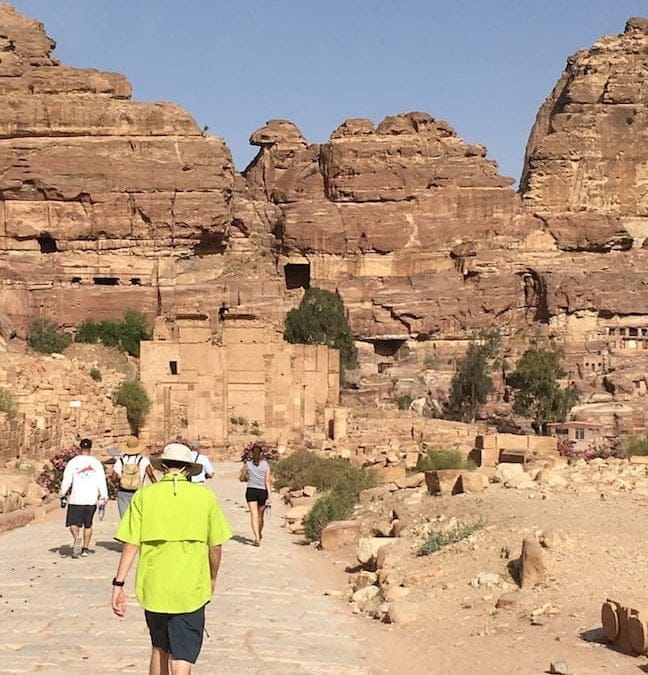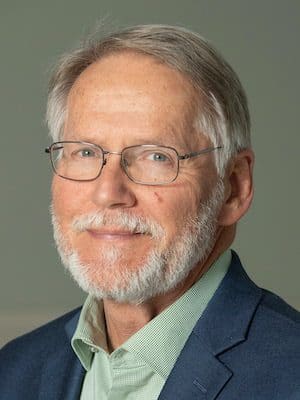Some stories are best told in pictures, and this blog will be mostly that – a bunch of pictures from Petra. Travelers with the Campbell University Divinity School/Nurturing Faith Experiences group were given a choice as we explored the Nabatean capital of Petra on Thursday.
One choice was to leave at 8:00 a.m. and enjoy a rather leisurely walk through the siq and into the ancient city of tombs – about four miles on a hot morning, downhill on the way in and uphill all the way out.
The other option was to get up early and go into the park with me at 6:45 a.m. so we could see the basic sights (the famous “Treasury,” featured in “Indiana Jones and the Last Crusade,” the street of facades, the Roman theater carved from limestone, and so forth. In addition, we would climb the arduous 850 rough-hewn and unevenly worn steps that zig zag up a canyon to an imposing temple to a deified Nabatean king erroneously known as the “Monastery.” The Monastery is also a façade, carved from the mountain, but far larger than the more famous Treasury, which is actually a one-room tomb.

The massive “Monastery” – to get an idea of scale, a woman is standing below the door opening, barely visible.
At the top of that climb lay the possibility of another steep ascent to a viewing point atop a ridge.
After coming down the same long stepped path, that group would have the option of walking halfway back out, then up another trail – slightly shorter but no less steep – to the “High Place of Sacrifice.” No one knows when the place first came to be used: possibly with the ancient Edomites, or perhaps with the Nabateans.
The high place is a plateau at the top of a high ridge that features two large obelisks carved from the natural sandstone, and beyond them a worship place also carved from the mountain top. It contains a double altar: one with a circular well and water basin that was apparently used for slitting the animal’s throat (a circular depression collected the blood and channeled it from the altar. Adjacent to it is another altar with a rectangular depression, apparently used to burn the sacrificial animal. Before the altars is a large rectangular triclinium – a hollowed out place with benches on three sides where worshipers would have sat, with a low offering table carved near the altars.

Shekanah Solomon was happy to get down from the Monastery, and caught a lift back up to a shopping area.
Those were the choices: a little more than half the group chose to join me on the adventurous route, and most of them made it to the Monastery, though some more slowly than others. The fast walkers had time to visit the high observation point while waiting for others to reach the Monastery, where a Beduoin tent offered shade and sold water and cold drinks.
By the time we got down and then reached the steps to the high place, about half the group bailed, but we were able to pick up one or two others from the later group for our hike up the circuitous path to the top. The sun was really beating down by that time, but everyone persevered, and all were rewarded with spectacular views from the high place, helping us to understand why it was so common in the ancient world – and so problematic for the Hebrews – that people wanted to worship on the high places.
For many folks, it was their first chance to ride a camel, a donkey, or a horse, which added to the adventure. The price of the $75 ticket into the park supposedly includes a horse ride up the last half mile, which is steep, sunny, and comes when most people are very tired. It’s understood that a $5 tip to the Bedouin horse wrangler is expected, but not even climbing to the Monastery was any harder than getting away from those guys, who continually pressed for more.
Our goal was for the “adventure group” to be back at the hotel by 12:30 p.m., and we came close. After climbing back aboard our buses, we stopped for a nice buffet lunch, then hit the road for a long ride to Aqaba, where we hope to arrive in time for a swim in the Gulf of Aqaba, the upper end of the Red Sea.
Fortunately, the bus has a surprisingly good wifi signal, even in the desert, allowing me to type, edit pictures, and post the blog between bumps.
Tomorrow we’re back in Israel, but the day won’t be any shorter: we begin with another border crossing, then a 3-4 hour ride to Masada, with further stops at Ein Gedi, Qumran, the Dead Sea, and Jericho before heading up the Jericho Road into Jerusalem, our home base for the next four days.
#CUDS_NFtour2017









